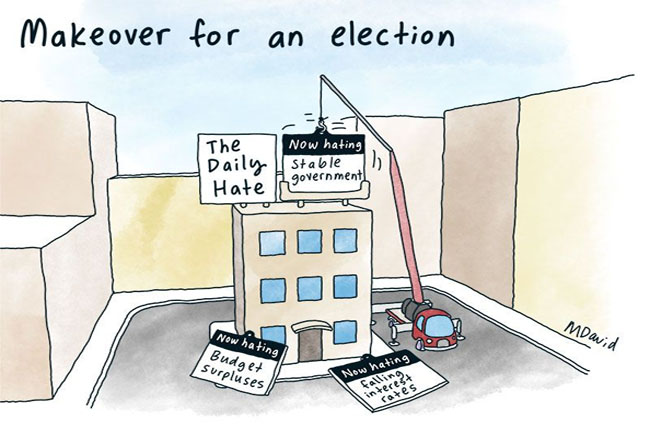Donald Trump promised Americans he would fix the ailing economy and make life better for Americans. He is achieving the opposite. All but the richest 10% are now worse off than they were.
Concealing these realities are jubilant headlines hailing the magnificent economic revival Trump has sparked. These are all fake news — falsified reports intended to dupe the gullible.
In these two respects – an incoming right-wing government damaging a strong economy and the mainstream media furiously denying this reality – the USA is today mirroring Australia over the last four years.
Fake news
Across America, false reports proliferate. ‘Economy runs strong in Trump's first year’, declared the Houston Chronicle. ‘Trump earns high marks from UBS for his economic policies’, claimed CNBC. The Canadian Times Colonist insisted, ‘Under Trump, U.S. economy is roaring back’.
News Corp routinely falsifies the record in Australia, Britain and the United States.
A columnist for The Australian gushed last week:
‘No American president in recent U.S. history has so dramatically improved the American economy, boosting pay rates, job numbers, retail sales, business investment, profits and, of course, the share market. It’s an astounding transformation that will create a tidal wave of repercussions around the world.’
The data proves the opposite.
Severe devaluation
One clear indicator of serious economic decline is the value of the U.S. dollar. Through the calendar year 2017, it fell 12.3% against the Euro, 11.7% against the South Korean won, 8.8% against the British pound, 8.4% against the Taiwan dollar, 8% against the Chilean peso, 7.8% against the Aussie dollar, 7.6% against Singapore’s dollar, 6.5% against the Canadian dollar and 6.2% against China’s yuan.
It fell by lower percentages against the Russian ruble, Mexico’s peso, the Swiss franc, the Japanese yen, the Kiwi dollar and most other global currencies.
Already in 2018, the U.S. dollar has fallen even further against all those currencies. The DXY Dollar Index tracks the value of the U.S. dollar against its trading partners. Yesterday, it hit its lowest level in more than three years.
Economic growth lagging the world
The U.S. economy grew at an annual rate of 2.3% up to the third quarter of 2017. This ranks 125th in the world. It ranked 124th last week but was overtaken yesterday by Guatemala. This is the lowest ranking on record.
Trade down the S-bend
The U.S. trade deficit deepened to $50.5 billion in November. A year earlier, this was just $46.4 billion. That’s a deterioration of almost 9%. The current deficit is the deepest since January 2012, nearly six years ago. This is despite the whole world now enjoying the strongest global trade boom since World War II.
Tourists staying away in their millions
A highly embarrassing statistic for the Trump Administration is the dramatic slump in tourist arrivals to the USA while global tourism numbers are at all-time highs.
For the year to July 2017, arrivals were 6.4% below the same period in 2016 and well below the equivalent levels for 2015 and 2014.
Stock market rises
U.S. stock markets surged in 2017. But so did almost all other stock exchanges. The Dow Jones industrial average rose 25.1%, which seems impressive. But given the global boom in trade, investment and corporate profits, that is below average.
Japan’s Nikkei 500, Brazil’s Bovespa, S&P Lima General in Peru, Nairobi’s All Share and Mumbai's Nifty 50 all climbed more than 25.1%. FTSE China A 50, Chile’s IGPA Select and Hong Kong’s Hang Seng rose more than 30%. Nigeria’s NSE All Share, Turkey’s BIST All Shares and Jamaica’s JSE Market soared more than 40%. Argentina’s Merval gained 77.7%.
Unemployment rate
In a shock result last week, 261,000 Americans filed for the dole. In one week. That was way above forecasts – much higher than the 245,000 recorded in the first week of 2017 – and confirmed all is not well with job creation.
The December jobless rate was 4.1%, unchanged from the previous two months, which ranks equal 47th in the world. Equal with Myanmar and Bangladesh. Good, but not world-beating. 6,576,000 Americans still need a job.
Wage growth and inflation
The rate of wage growth slowed during 2017 to just 2.5%. That’s a substantial decline from the rise in calendar 2016 of 2.85%.
Inflation through the year to December was 2.1%. Hence the real pay increase under Trump was just 0.4%, down from 0.75% in 2016.
Government debt ballooning
Borrowings actually declined through the first half of 2017, continuing the trend of the late Obama years. The debt then blew out by a staggering $400.4 billion in September, with more added in October and November. Over the full year, debt increased by $516 billion.
Just in the first 16 days of January, the debt has risen by another $270 million.
Only four countries now have debt above 100% of gross domestic product and still rising rapidly. They are Mozambique, Bhutan, Lebanon and the USA.
Household debt dangerously high
Credit card and other consumer debt soared during 2017 to $3.83 trillion. Student and car loans also increased alarmingly.
Household savings for the third quarter in 2017 slumped to the lowest level since the third quarter in 2008, at the depths of the global financial crisis.
The obvious danger here is that consumers are swallowing the fake news that the good times have arrived and are spending money they don’t have and will never get.
Why is this happening?
The reasons the Republican Administration seems intent on destroying the wellbeing of most Americans vary. Some commentators claim this is the consequence of shifting wealth and income to the top end.
Nobel prize-winning economist Paul Krugman believes, in contrast, that “cruelty” is the objective:
‘Over the past few years it has become increasingly clear that the suffering imposed by Republican opposition to safety-net programs isn’t a bug, it’s a feature. Inflicting pain is the point.’
Whatever the motivation, the outcomes are clear. On nearly all major criteria, except the advance of the stock markets and – arguably – manufacturing output, the U.S. economy is deteriorating.
2018 will be critical for America’s economic and social future.
You can follow Alan Austin on Twitter @AlanAustin001.

This work is licensed under a Creative Commons Attribution-NonCommercial-NoDerivs 3.0 Australia License
Monthly Donation
Single Donation
No fake news. Subscribe to IA.











